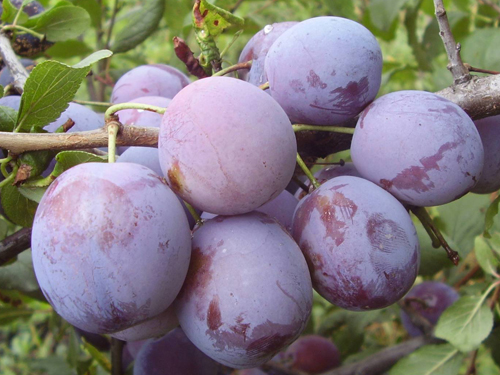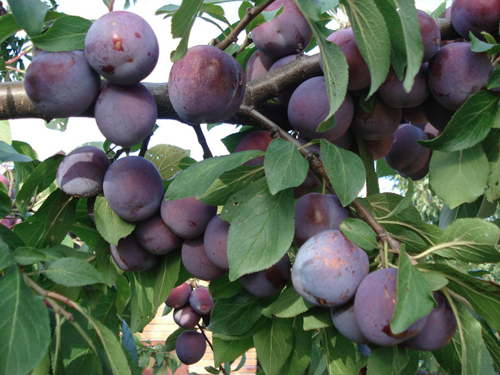Plum variety Renklode Soviet
The group of plums, united by the name Renclaude, has quite a few representatives who are respected by gardeners. Each species has certain qualities. Renklode's Soviet characterization is more than positive. The variety was created at the Rossosh Zonal Experimental Station, where, by crossing the Record and Renklod Ulyanishchev varieties, it was possible to obtain a novelty. The authorship belongs to A. Ya. Voronchikhina. The application for registration was filed in 1976, the variety was entered into the State Register of Plants of the Russian Federation in 1986. The tree is zoned in the Central Chernozem region (Belgorod, Voronezh, Kursk, Tambov, Lipetsk regions). The Soviet Renklode was especially popular in the Voronezh and Belgorod regions; it also brings good harvests in Rostov.
Description
Plum has a weak growth force, therefore, even at an adult 15 years of age, it does not exceed 3 meters. The crown is sloppy, broom-like or wide-pyramidal, raised, sparse, with a slight degree of foliage, which, in principle, is good for fruits that get more sun. The type of crown was passed on to the variety by inheritance from Renklod Altan, the seedling of which is one of the parental forms - Renklod Ulyanischeva. The stem is covered with a gray-brown bark, a feature of which is strong longitudinal cracking. The convex lentils of the usual size are rather densely located. Defects in the structure of wood, curliness, were not revealed in the plum. Straight-growing shoots have short internodes, the bark is violet-brown, covered with dense pubescence. The buds of the Soviet Renklode, consisting of leaf primordia, are rather large - 5 - 6 mm in length, conical, with a pointed apex. Flower buds are 2 times smaller, the same conical shape with a sharp top. Both types of buds are located at a distance from the shoot.

Leaves are oval, somewhat elongated, with pointed tips, rounded base. The size of the leaf plate of the variety varies depending on the location. On annual shoots, the length of the leaf is about 7 - 8 cm, width is 4 - 5 cm, on the spurs, the size of the leaves varies greatly - in length from 6 to 12 cm, in width from 3 to 6. On the spurs, the leaf plate can also have a different shape - obovate or elongated obovate with a blunt-pointed apex and a wedge-shaped or narrow-wedge-shaped base. The surface of the leaves of the Soviet Renklode is flat, dark green, shiny, not pubescent. The bottom is lighter and hairy-pubescent throughout the entire area. The leaves, located at the base of the annual shoots of the plum, have a rather strong bulge along the central vein, a leathery surface and a medium double-crested edge serration. The petiole is short, 1.2 - 2 cm long, without stipules. 2 glands of medium size are painted in a muddy burgundy shade.
The inflorescence usually consists of two small flowers with a diameter of 20 - 25 mm. Petals are white, rounded, slightly corrugated, closed. The peduncle is short, slightly more than 1 cm, has strong pubescence. The tube of the calyx is naked, similar to a bell, its length is 3 - 4 mm, the color is light green. Small, about 3 mm long, the sepals are prominent, concave, pubescent inside, glabrous outside. The pistil of the variety is almost flush with the stamens. The length of the stamens is 6 - 9 mm, the pistil with the ovary is 10 - 12 mm. The ovary is naked.
The fruits of the Soviet Renklode are regular, rounded, almost flattened from the sides, sometimes onion, slightly asymmetric. Large plums - height, width and thickness 4.3 cm. Average weight - 40 grams, maximum - 80 grams. The apex is rounded, the funnel is narrow and shallow, the base is slightly rounded or flat. The abdominal suture is wide and shallow, clearly defined, not prone to cracking. The skin is smooth, the main color is green. At the stage of biological ripeness, the integumentary cover occupies the entire surface of the fruit, manifesting itself in a dark purple tint in the sun, and in the shade it can be brown-violet.The surface of the fruit is densely covered with a bluish waxy coating. The pulp of the variety is amber-yellow, in overripe fruits it is dull brown-yellow. The consistency is medium-dense, gristly, very juicy. Softens when overripe.
The plum has a very pleasant taste - sweet, but not sugary, with a slight sourness. Assessment of tasters 4.3 - 4.5 points. The content of substances in 100 grams of the pulp of the Soviet Renklode: dry soluble substances - 14.1%, sugar - 9.2%, titratable acids - 1.7%, pectins - 0.3%, ascorbic acid - 7.7 mg. The stone is small, weighing 1.2 grams, which is 2.9% of the total weight of the entire fruit. It is oval or broadly oval in shape, with a broadly rounded apex and base, which is slightly sloped, the dorsal suture is moderately open along the entire length, the ventral suture is narrow, with a moderately pronounced central rib and clearly visible lateral ribs. The surface is smooth, dimensions - 23 mm long, 17 mm wide. The cavity in which the bone is located is spacious. At full maturity, the bone is easily separated from the pulp.

Variety characteristics
- Trees grafted onto plum seedlings have good early maturity. During the fruiting period, they enter 4 years after planting;
- flowering takes place in medium terms;
- ripening period is medium early. In the south of the Central Black Earth Region, harvesting occurs in mid or late August;
- the yield of the Soviet Renklode is beyond praise. In the first 4 years of fruiting, the tree brought 9.7 kg each, while the control Record - only 3.8 kg. During the period of full fruiting, the average yield was up to 33.6 kg per tree, in contrast to the Record - 18.7 kg. In favorable years, the average yield reached 37 - 40 kg per tree, and some specimens brought in 50 - 60 kg;
- this plum is self-fertile;
- for the Central region, the variety shows good winter hardiness. Even in unfavorable years at a temperature of -34 ° C, the average degree of freezing did not exceed 2 points. Generative buds are also highly resistant to frost - at an absolute minimum of -34 ° C, they almost did not suffer, only 1.6% of the total died;
- immunity in general is at a high level. During the years of the spread of clasterosporium disease and in the absence of a fight against it, the defeat was only 2 points. The resistance to moniliosis is high - over the years of testing with this disease, the plum has never been sick. But it was strongly affected by polystygmosis, especially in the years when this disease covered large areas. Then the defeat was 3-4 points;
- Although the variety is characterized by universal use of the fruit, its main mode of consumption is in natural form. Also suitable for making jams, confiture, juice, marshmallow and marmalade. But for the compote, the Soviet Renklode is not suitable - the fruits become very limp and give the drink a turbidity.
Agrotechnics
The variety develops well on fertile loams and chernozems, which just prevail in the growing region. Plum planting can be done in autumn or spring, but on time. After spring planting, the seedling needs more careful care, especially watering. In the fall, it is important to have time to plant the plant 2 - 3 weeks before the onset of a stable cold snap.
Adult specimens do not tolerate excessive moisture, so the soil must be loosened after watering or rain. The watering itself should be uniform, taking into account the precipitation. In spring, nitrogen-containing fertilizers will help accelerate the growth of plums, mineral fertilizers are preferable in autumn. All growing shoots should be removed. In order for the tree to bring harvest annually, in the spring, before the sap flow begins, it is imperative to prune it. If the branches cannot withstand the weight of the crop, it is necessary to put props under them.
Soviet Renklode is perfect not only for private estates, this variety is actively cultivated in industrial gardens.Good winter hardiness, high consumer qualities of fruits, excellent productivity and good immunity - all this helps the plum to keep its leading position for more than a dozen years. The cons can be called relative. Polystygmosis can be dealt with through preventive measures, and the boiling pulp is perfect for making jam.









A good variety of plums. We have been growing for the second year and already have fruits (they dug it out from the neighbors, he was about 3 years old). Fruits are medium in size, juicy. I cooked plums from them in my own juice and compote. Both are very tasty.
This variety needs to form a crown, otherwise it will not be known what. Every spring and autumn we remove the extra branches, and the husband cuts the tops so that she does not grow very high.